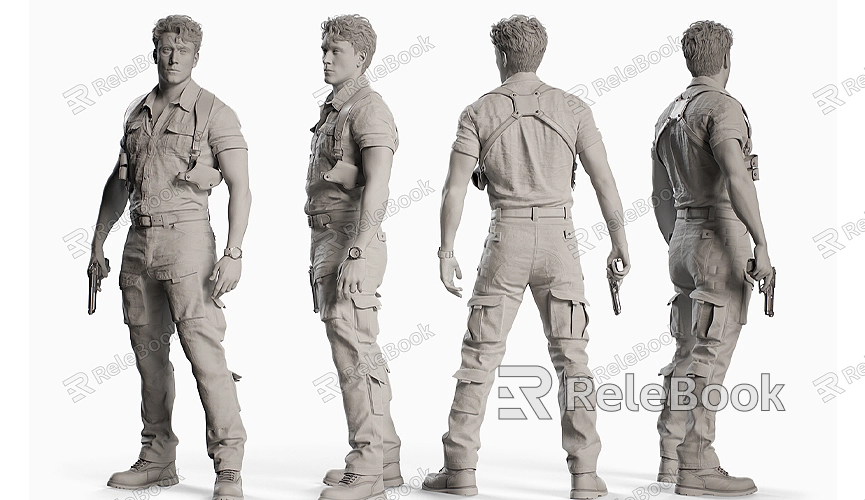How to Use Blender to Create 3D Models
Blender is a powerful open-source 3D creation tool suitable for modeling, rendering, animation, and more. For those new to 3D creation, Blender offers a wealth of features and flexible tools. This article will guide you through the process of creating 3D models in Blender, from basic modeling to fine-tuning details, helping you successfully complete your 3D designs.
1. Installing and Setting Up Blender
First, you need to install Blender on your computer. Visit the official Blender website to download the latest version and follow the installation instructions. Once installed, launch Blender, and you'll see a blank workspace.

Setting Up the Workspace
After opening Blender, you can customize the workspace according to your needs. For example, adjust the layout of the toolbar and choose shortcuts that suit you to ensure a smooth workflow. As a beginner, consider exploring Blender’s tutorials to familiarize yourself with commonly used tools and operations.
2. Creating Basic 3D Models
Adding Basic Geometry
In Blender's default workspace, you’ll see a default cube. You can add more basic geometric shapes with the following steps:
1. Open the Add Menu: Click the “Add” button in the top left corner.
2. Select Geometry: Choose “Mesh” and then select the desired geometric shape, such as a sphere, cylinder, or plane.
3. Adjust the Model: Use Blender’s “Move,” “Rotate,” and “Scale” tools to adjust the position, angle, and size of the newly added geometry.
Modeling in Edit Mode
1. Switch to Edit Mode: Select the geometry you want to edit and press `Tab` to switch to Edit Mode.
2. Select and Modify Vertices: In Edit Mode, you can select individual vertices, edges, or faces and manipulate them. For example, use the “Select” tool to choose a vertex and the “Move” tool to adjust its position.
3. Refine the Model: Use tools like “Extrude,” “Subdivide,” or “Merge” to refine your model. These tools allow you to add more detail or modify the existing shape of the geometry.
3. Applying Materials and Textures
Adding Materials
1. Select the Material Panel: In the properties panel on the right, select the “Material” tab.
2. Create a New Material: Click the “New” button to create a new material, setting properties like color and reflectivity.
3. Assign the Material: Apply the material to your selected geometry to achieve different visual effects.
Applying Textures
1. Switch to the Texture Panel: In the “Material” panel, select the “Texture” tab.
2. Add a Texture: Click the “New” button, then choose the type of texture you need, such as an image texture.
3. Load the Texture File: Click the “Open” button, select your texture file, and apply it to the model.
4. Rendering with Lights and Camera
Adding Lights
1. Insert Lights: In the “Add” menu, select “Light” and choose the appropriate type (point light, spotlight, or sunlight).
2. Adjust Light Position: Use the “Move” tool to adjust the light’s position and angle, ensuring the best effect for your model during rendering.
Setting Up the Camera
1. Insert a Camera: In the “Add” menu, select “Camera.”
2. Adjust Camera Angle: Select the camera and use the “Move” and “Rotate” tools to adjust its viewpoint and position.
3. Preview Rendering Effects: Press `0` to switch to camera view and see how the model appears from the current camera angle.
Rendering Settings
1. Choose a Rendering Engine: In the properties panel on the right, select the “Render” tab and choose a rendering engine like “Cycles” or “Eevee.”
2. Set Output Parameters: Configure the rendering resolution and image format as needed.
3. Start Rendering: Click the “Render” menu and select “Render Image” to generate the final image of your 3D model.
5. Finding More Resources
When creating models and virtual scenes, high-quality 3D textures and HDRI resources can significantly enhance your work. If you need a wide variety of high-quality 3D textures and HDRI, you can download them for free from [Relebook](https://textures.relebook.com/). For beautiful 3D models, visit [Relebook](https://3dmodels.relebook.com/), which offers a plethora of premium 3D resources.
Using Blender to create 3D models is a creative and challenging process. From adding basic geometry and refining models to applying materials and textures, as well as setting up lights and cameras, each step requires careful operation and adjustment. By mastering these techniques, you can achieve complex 3D designs and rendering effects in Blender. I hope this guide helps you better utilize Blender to create 3D models and enhance your creative skills.

